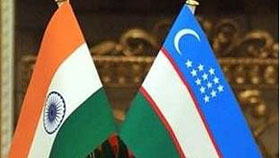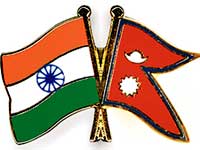August 2020 India and the World
Sakshi Education
- India, Uzbekistan Co-Chaired First National Coordination Committee Meet
 India and Uzbekistan co-chaired the first National Coordination Committee meeting on 24th August 2020.
India and Uzbekistan co-chaired the first National Coordination Committee meeting on 24th August 2020.
The members discussed issues of bilateral interests such as Line of Credit (LoC) projects, trade, and investment.
The National Coordination Committee meeting was co-chaired by Minister of State for External Affairs V Muraleedharan and Uzbekistan Deputy Prime Minister Sardor Umurzakov.
Highlights:
The members, during the meeting, agreed to work to deepen India-Uzbekistan strategic relations.
India and Uzbekistan have a bilateral trade turnover of over $300 million. Pharmaceuticals is a major area of both trade and investment by India.
It should be noted that the ties between the two countries in terms of Medical tourism has increased sharply in the recent past.
Indian has made notable investments in Uzbekistan have been made by Indian companies in the fields of pharmaceuticals, amusement parks, automobile components, and hospitality industry.
A Joint Centre for Information Technology (IT) was set up in 2006 and it was upgraded in 2014.
Also, an IT Park in Tashkent was established with Indian assistance. It was inaugurated in July 2019.
- India-Vietnam Meeting
The 17th meeting of India-Vietnam Joint Commission on Trade, Economic, Scientific and Technological Cooperation was held.
Both sides reviewed the recent developments in India-Vietnam Comprehensive Strategic Partnership (since 2016) and discussed the future trajectory of their wide-ranging engagement.
Key Points
India and Vietnam agreed to enhance their bilateral cooperation in line with India’s Indo-Pacific Oceans Initiative (IPOI) and the ASEAN’s Outlook on Indo-Pacific to achieve shared security, prosperity and growth for all in the region.
This has come in the backdrop of China’s aggression in the Indo-Pacific region including South China Sea region and its actions along the Line of Actual Control (LAC) with India.
China claims sovereignty over most of the South China Sea, which is seen as having huge reserves of hydrocarbons and minerals. However, several ASEAN (Association of Southeast Asian Nations) member countries, including Vietnam, Philippines and Brunei, dispute the Chinese claims.
Both sides agreed to coordinate closely at multilateral forums, including at the UN Security Council, where both India and Vietnam will serve concurrently as non-permanent members in 2021.
They also agreed to step up cooperation and coordination at important regional forums under the ASEAN framework.
They agreed to explore closer cooperation in emerging areas such as civil nuclear energy, space, marine sciences and new technologies.
India reaffirmed its development and capacity building assistance to Vietnam through initiatives such as Quick Impact Projects (QIP), Indian Technical and Economic Cooperation (ITEC) and e-ITEC initiatives, PhD fellowships, as well as projects in water resource management in Vietnam’s Mekong Delta region, SDGs, digital connectivity and heritage conservation
- BRICS 5G Innovation Base
China has proposed the creation of a BRICS innovation base in China to take forward 5G and Artificial Intelligence (AI) cooperation among the five countries of BRICS i.e. Brazil, Russia, India, China and South Africa.
Key Points
China urged fellow nations, including India, to boost cooperation in areas including 5G and Artificial Intelligence.
This move could pose a conundrum before India who is having issues with China in recent times but other countries seem to willing to allow China’s participation in their 5G networks.
India is unlikely to allow Chinese participation in the roll-out of its national 5G network, particularly in the wake of recent moves to tighten investment from China and to ban 59 Chinese apps, citing national security concerns.
A high-level committee on 5G is opposed to including Chinese vendors including Huawei in the 5G trials.
Indian intelligence assessments have also expressed concerns on the possible direct or indirect links of several Chinese companies, including Huawei, with the Chinese military.
India has made clear that a return to normalcy cannot be possible while tensions along the Line of Actual Control remain unresolved.
It needs to be noted that India has recently joined the 'Global Partnership on Artificial Intelligence (GPAI)' as a founding member to support the responsible and human-centric development and use of Artificial Intelligence (AI).
Russia has agreed to work with China on 5G and with Chinese telecommunications firm Huawei, which has been largely banned by the United States.
Huawei has been at the centre of rising USA-China tensions over technology and security.
The USA has restricted China’s access to chip making tools. Huawei may face shortages in supply of processor chips for which it relies on the USA.
In South Africa, Huawei is providing services to three of its telecom operators in the roll-out of their 5G networks.
Brazil has allowed participation of Huawein in 5G trials. More than a third of Brazil’s 4G network operators use Huawei equipment. Brazil maintains that Huawei has capacity above its international competitors.
- India and Nepal to speed up implementation of projects in the Himalayan nation
 A virtual meeting was held between the Senior diplomats of India and Nepal to review the progress made on various India-aided developmental projects being implemented in the Himalayan nation.
A virtual meeting was held between the Senior diplomats of India and Nepal to review the progress made on various India-aided developmental projects being implemented in the Himalayan nation.
The meeting was held virtually due to the covid-19 pandemic. The meeting was the 8th round of talks under the aegis of the India-Nepal Oversight Mechanism.
Highlights:
The Nepalese side was lead by the Foreign Secretary Shanker Das Bairagi and the Indian side was led by the Ambassador to Nepal Vinay Mohan Kwatra.
The delegations represented their respective countries during the oversight mechanism meeting.
The officials assessed the progress made on various India aided development projects being implemented in Nepal.
India and Nepal officials have reviewed the status of various development projects supported by New Delhi in the Himalayan nation.
Both nations has decided to speed up their implementation against the backdrop of consistent efforts by China to draw Nepal into its sphere of influence with cheap loans and infrastructure projects.
The meeting also included the ongoing projects including the cross-border railway connectivity, construction of roads in Nepa’s Terai region, the Arun-III hydropower project, and petroleum product pipelines.
- Fourth Meeting of the BRICS Anti-Drug Working Group held
The 4th Session of the BRICS Anti-Drug Working Group comprising of Brazil, Russia, India, China, and South Africa was held virtually.
The Indian delegation was led by Shri Rakesh Asthana, Director General, Narcotics Control Bureau. The session was held over the video conference on August 12, 2020. The 4th session was chaired by Russia.
Highlights:
The countries adopted reaffirming the commitment of the five-member states to the International Anti-drug conventions.
India recommended for nodal points to enable real-time information sharing among BRICS nations.
The countries exchanged opinions concerning the drug situation in their countries, the international and regional trends of illegal trafficking in narcotic drugs.
The officials also discussed the psychotropic substances and their precursors, and the impact of various internal and external factors on the situation.
The virtual meeting also focused on the misuse of darknet and other advanced technologies for drug trafficking.
- India-Nepal Talks
 The ambassadors of India and Nepal are likely to meet in Kathmandu (Nepal) to review projects funded by the Indian government.
The ambassadors of India and Nepal are likely to meet in Kathmandu (Nepal) to review projects funded by the Indian government.
The meeting is likely to take place via videoconference in view of the Covid-19 pandemic situation.
Key Points
This meeting will be a part of India- Nepal Joint Oversight Mechanism.
The mechanism was established in 2016 to review ongoing bilateral economic and development projects.
The government of India has allocated Rs. 800 crore in budget 2020-21 for projects in Nepal.
These projects include building roads in the Terai region, helping Nepal in its post-earthquake (2015) reconstruction work, building railway lines, a police training academy, a polytechnic college, an oil pipeline and border check posts.
Recently, a Memorandum of Understanding (MoU) was signed between India and Nepal for the construction of a sanitation facility at the Pashupatinath Temple, Kathmandu.
This meeting is important in light of recent tensions between India and Nepal.
In 2017, Nepal signed up to China's Belt and Road Initiative (BRI), which sought to create highways, airports and other infrastructure in the country. BRI was rejected by India and this move of Nepal was seen as an inclination towards China.
In 2019, a new political map of India, made after the bifurcation of the state of Jammu and Kashmir (J&K) into the Union Territories of J&K and Ladakh, showed Kalapani, Lipulekh and Limpiyadhura as part of Pithoragarh district in Uttarakhand state.
India and Nepal have border disputes over Kalapani - Limpiyadhura - Lipulekh trijunction between India-Nepal and China and Susta area (West Champaran district, Bihar).
Nepal objected strongly against this map and opinionated that the issue should be resolved through negotiations.
Further, the inauguration of a road up to Lipulekh Pass (for Kailash Mansarovar Yatra) by the Indian government on the border with China sparked more protests from Nepal.
In retaliation, Nepal released a new map that includes all the disputed territories claimed by India.
- India-China discuss on Depsang Plains
Recently, India and China have held talks at the Major General-level to discuss issues concerning the strategic Depsang Plains.
The talks were held at Daulat Beg Oldie (DBO) and were limited to Depsang to discuss issues of varying claims and also blocking patrols by each other.
Key Points
About the Meeting:
This was the first high level talks post Galwan clash of 15th June 2020.
Military talks since then have been limited to Corps Commander level.
The meeting only discussed routine patrolling patterns by both sides as part of border management leaving aside disengagement or de-escalation.
Depsang Plains:
The Depsang Plains along with Pangong Tso are the two major areas of concern in the ongoing standoff along the Line of Actual Control (LAC) in eastern Ladakh.
Despite the strategic importance of the Depsang Plains, the series of military talks held so far have focussed on the standoff areas at Galwan, Gogra Hot springs and Finger area of Pangong Tso.
Depsang is one of the few places on the LAC where tank manoeuvres are possible.
During the 1962 war, Chinese troops occupied the Plains. In 2013, Chinese troops came 19 km inside and pitched tents resulting in a 21-day standoff.
Issues:
There is a heavy Chinese presence at a crucial area called the Bulge, in the Depsang Plains.
Chinese troops have blocked the Indian Army patrols from reaching the various patrolling points.
There has also been a build-up of tanks and armored vehicles on the Chinese side very close to the LAC.
Threats:
It threatens Indian positions at Burtse and RakiNala inside Indian territory and further DBO by bringing Chinese troops closer to the 255 km long crucial Darbuk-Shyok-DBO road.
Depsang is also close to the Karakoram Pass, overlooking the very strategic Saltoro Ridge and Siachen glacier.
Challenges:
While addressing the India@75 Summit organised by the Confederation of Indian Industries (CII), the External Affairs Minister of India held that reaching an understanding with China is a huge challenge before Sino-Indian relations.
Both countries are demographically very unique with the billion-plus populations.
There is a parallel but differential rise happening at a time when both are neighbours as modern states which puts a huge premium on reaching some kind of equilibrium or understanding between the two.
- Operation Breathing Space: India-Israel
 Recently, an Israeli team arrived in India with a multi-pronged mission, codenamed Operation Breathing Space to work with Indian authorities on the Covid-19 response.
Recently, an Israeli team arrived in India with a multi-pronged mission, codenamed Operation Breathing Space to work with Indian authorities on the Covid-19 response.
Key Points
Development of Test Kits:
India’s Defence Research and Development Organisation (DRDO) and Israel’s defence ministry research and development team are working together to develop four different kinds of rapid testing kit for Covid-19 which can give the result within 30 seconds.
Types of Tests:
The tests include an audio test, a breath test, thermal testing, and a polyamino test which.
In the audio test, a patient’s voice would be recorded and evaluated through artificial intelligence and machine learning.
In the breath test the patient will blow into a tube that will detect the virus using terra-hertz (high frequency) waves.
Thermal testing will enable identification of the virus in a saliva sample.
Polyamino acids test seeks to isolate proteins related to Covid-19.
India Specific Approach:
The kits will be jointly developed after trials on Indian Covid-19 patients. The tests have already been tried on a small sample of Israeli patients.
Other Assistance:
The Israeli team has brought robotic equipment, and wrist monitors that will help doctors and nurses monitor a patient without increasing risks of infection to themselves.
The team has also brought 83 advanced respirators to help patients with severe symptoms.
Benefits:
The success of rapid tests will help India’s overworked health-care professionals, who are experiencing fatigue. It will also help to address the public impatience over the Covid-19 test.
The quicker test will help authorities to take quicker prevention measures, which will reduce the spread of the virus among people.
- Tsunami Ready Programme: UNESCO-IOC
Recently, the Intergovernmental Oceanographic Commission (IOC) of UNESCO (also known as UNESCO-IOC) has approved the recognition of two communities of Odisha viz., Venkatraipur and Noliasahi as Tsunami Ready Communities.
With this recognition, India has become the first country in the Indian Ocean Region to achieve the honor from the UNESCO-IOC.
Odisha is the first state in India to have such recognised communities.
Key Points
Tsunami Ready:
It is a community performance-based programme initiated by the Intergovernmental Oceanographic Commission (IOC) of UNESCO to promote tsunami preparedness through active collaboration of public, community leaders, and national and local emergency management agencies.
The main objective of this programme is to improve coastal community's preparedness for tsunami emergencies, to minimize the loss of life and property and to ensure a structural and systematic approach in building community preparedness through fulfilling the best-practice indicators set by the Intergovernmental Coordination Group for the Indian Ocean Tsunami Warning and Mitigation System (ICG/IOTWMS) of UNESCO-IOC.
Implementation in India:
Tsunami Ready in India is implemented by the National Board (Ministry of Earth Sciences- MoES) under the Chairmanship of Director, Indian National Centre for Ocean Information Centre (INCOIS) with members drawn from MoES, National Disaster Management Authority (NDMA), Ministry of Home Affairs (MHA), Odisha State Disaster Management Authority (OSDMA), Andaman & Nicobar Islands Directorate of Disaster Management (DDM) and INCOIS.
INCOIS (an autonomous body under the Ministry of Earth sciences) is also providing tsunami advisories to Indian Ocean region (25 countries) as a Tsunami Service Provider as the responsibility assigned by UNESCO-IOC.
The Indian Tsunami Early Warning Centre (ITEWC), INCOIS is the nodal agency to provide tsunami advisories to India. It is coordinating with the Disaster Management Officials (DMOs) for implementation of Tsunami Ready programme in India.
It conducts IOWave Tsunami mock exercises biannually in coordination with ICG/IOTWMS and also conducts mock exercises at national level in alternative years in coordination with MHA and NDMA and State Disaster Management Agencies (SDMA) to strengthen the readiness to handle the emergency situations with stakeholders.
- India extended Line of Credit worth USD 18 million dollars to Maldives
Government of India has extended Line of Credit (LoC) worth $18 million to the Government of Maldives. The aim is to expand the fishing facilities at Maldives Industrial Fisheries Company (MIFCO).
Highlights:
The project aims to invest in fish collection and storage facilities.
The fund will be used for setting up of a tuna cooked plant and fishmeal plant.
This is a part of the $800 million LoC offered by India with repayment tenor of 20 years and a 5-year moratorium.
In Male, fishing is connected to the Maldivian way of life as it is a key driver of the economy through exports.
Published date : 19 Aug 2020 04:03PM


















